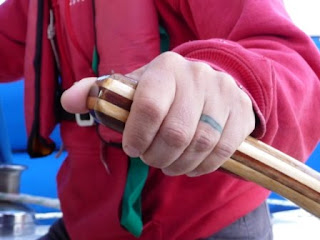We are not total purists, but we do try to sail from anchorage to anchorage where possible. However we sometimes enjoy those flat calm days as it makes for excellent marine mammal spotting. Sometimes this wildlife spotting has a tendency to bite us. Take the day near Coronados we spotted pilot, fin, humpback, and blue whales, plus bottlenose and common dolphins. It was flat calm and so the engine was on and we were meant to be jumping 20 miles north before a forecast strong norther. It was handy to use the engine to find them, but also handy later in the day to motor sail with 2 reefs into what became an exciting 6 foot chop before we bore off to our destination late in the afternoon.
We have a Yanmar 3GM30 27 Horsepower. I think we could have got away with the 2GM as we replaced a Volvo MD2 16HP when we bought the boat 7 years ago. But in times like we've had it's been nice to have the extra push. On the other hand, maybe we would be less pig headed and turn to run with the wind to seek shelter.
At 5 knots our range is about 450nm with all tanks filled. That’s one large stainless tank of 135L, a flexible tank of 45L and a couple of jerry cans. If it is flat water we could eke out another 50nm but as we have learnt, a good heel on starboard tack puts a nice airlock in the system making the last 35L in the tank fairly useless due to poor tank design. When we learnt this lesson after a great day of tacking up Johnstone Strait, we fortunately only needed the one minute it took to run the fuel pipes dry and coasted the remainder of the way into the anchorage.
To get fuel from the flexible tank to the main tank is done by a hand pump. In a rough sea, this is a rather nauseating process as the diesel fumes fill the cabin. Fortunately this is a rare need and has only twice been required on long passages.
Since leaving Alert Bay in July 2009 and arriving in Guaymas, we've put 472 hours on the engine. We don't use it to charge batteries or make water and sail as much as we can, with < 2kns of speed in a rolly sea being our usual patience level for starting the engine. The shocking truth is that the engine has been on for close to half of our distance travelled, nearly 4000nm. Much of this would be motor sailing but it still surprised us.
If we call ourselves eco friendly, then buying 1000L of diesel a year had better be worth it. For all the hours simply spent looking at wildlife, we can only hope that the sighting reports we send in to Whaleforce (www.ceinst.org) , or photos and sound recordings to scientist friends helps to offset some of that karma. Saying that, we hope to be off in search of the endangered Vaquita later this year purely for selfish curiosity.
We are now in the boatyard in Guaymas where it was 35C inside the boat yesterday. Heidi spends her day with sheets, sarongs and clothes pins, trying to provide every square inch of shade possible. There’s an eccentric collection of characters living on their boats despite the heat. It makes us feel soft as we are about to get on a plane to Canada and run from the desert (and work for the summer and boost that hungry cruising kitty). We’ll try to keep in touch while on home territory, especially if we can organize some adventures!




.JPG)

.JPG)

.JPG)


.JPG)
.JPG)

.JPG)


.JPG)




.JPG)
.JPG)
.JPG)

